
 We
had prioritized our July-Aug 2010 trip to Brazil to search
first-and-foremost for large mammals. As detailed elsewhere on this
trip report, we did very well with birds, but our prime focus was a
targeted list of specialty mammals. We were fortunate in finding four
of the "top five" on our want list [Giant Armadillo was missed — it is
basically hopeless]. We were very happy with the rest.
We
had prioritized our July-Aug 2010 trip to Brazil to search
first-and-foremost for large mammals. As detailed elsewhere on this
trip report, we did very well with birds, but our prime focus was a
targeted list of specialty mammals. We were fortunate in finding four
of the "top five" on our want list [Giant Armadillo was missed — it is
basically hopeless]. We were very happy with the rest.
We encountered only one Giant Anteater Myrmecophaga tridactyla
(above, right & below) but the experience was superb. We had seen
it at dusk from a great distance on one day, and were able to arrange
access to the private ranch near Emas NP where it was foraging the next
day. We walked fairly close with care, and enjoyed wonderful views as
it actively ripped termite burrows apart to feed.
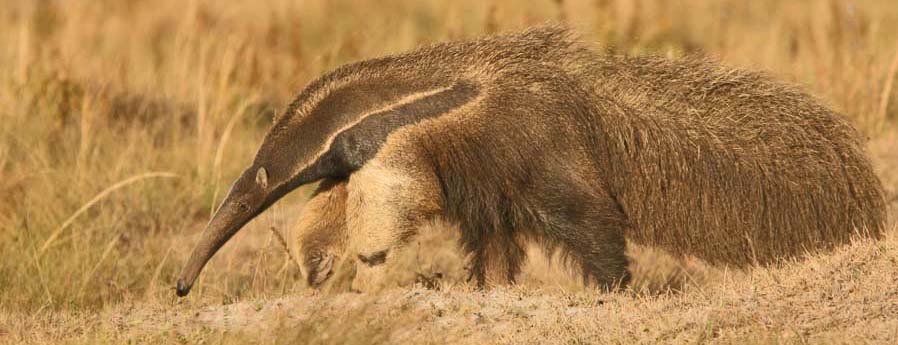
| Equally impressive in many ways was an encounter with a second species of anteater: Southern Tamandua Tamandua tetradactyla (right & below). This was shortly after dusk in the southern Pantanal, along a little-used side road off the Transpantaneira. While Marcelo was spotlighting as we drove, he located a female Tamandua carrying a baby that was almost as large as she was (below)! The two of them lumbered along as we gently approached on foot with the spotlight. When the mother reached a tree, she simply climbed straight up and away from us (right). I'd also hoped to encounter a live tamandua (having found several dead on Latin American roads) but to actually see a mother and baby like this was impressive. | 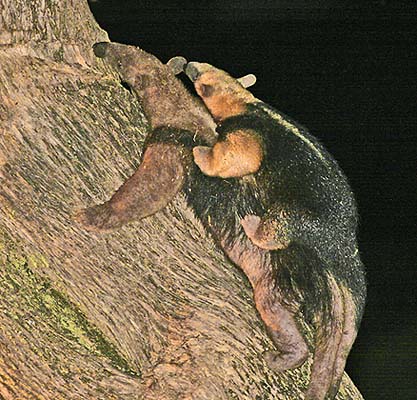 |

 |
Driving to and from Emas NP at dawn and dusk, we encountered Yellow Armadillo Euphractus sexcinctus several times. This one (left) was heading for its burrow in the red soil. [We saw several huge burrows dug by Giant Armadillo Priodontes maximus — and even got the van stuck in one — but had no luck finding the huge dasypod]. |


| A great spectacle of nature in the Pantanal was watching innumerable bats appear over the Rio Cuiaba at dusk. Twice we were still on a boat on the river at dusk, and twice we had hundreds of bats. Many were the huge Greater Fishing Bat Noctilio leporinus (above & right). These are very large bats with long tails they used to maneuver low to the water (above; or do they also use the tail to help catch fish?). They apparently have sickle-like claws with which they gaff fish at the surface. We also saw a few Lesser Fishing Bat N. albiventris among them (but no photos); these apparently eat mostly water beetles. | 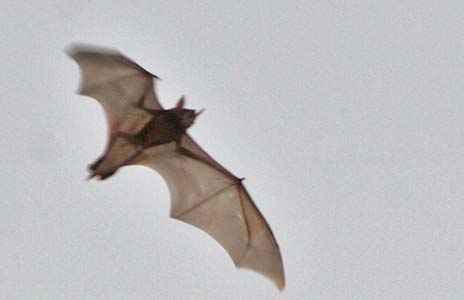 |
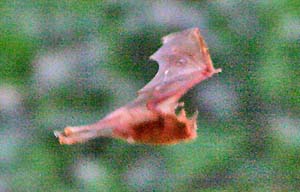 |
The photos above were taken at dusk with high ISO, but I also snapped some with flash. These shots look totally black, but when lightened in PhotoShop (left & below) they show that the flash has illuminated the bat and shown its color: Greater Fishing Bat can be a rich rust-orange (mostly males, per Emmons 1990). The alternative name is Bulldog Bat because the face is split, creating two 'jowls' and a 'bulldog' look; you can get a sense of that in the shot below. |

| Our boatman also knew a day roost for Long-nosed Bat Rhynchonycteris naso (right). These roosts are well-described in Emmons (1990): "They roost in the open over or beside water, on the lower side of .... a leaning tree trunk. They roost in groups of 3–45, usually about 12, and hang in characteristic straight line, with each bat spaced 2–4 cm from its neighbors. ... If approached too closely, the entire group flies off like a little flock of moths." And they did . . . . but were back again the next day. | 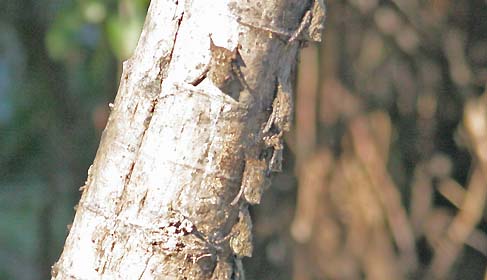 |
 |
At Emas NP we went to a remote mud-wallow in the western part of the park to observe a pack of ~50 White-lipped Peccary Tayassu pecari of all ages, including this big male (left). Marcelo saw a South American Coati Nasua nasua in the Pantanal; we all saw two more at Itatiaia NP. |
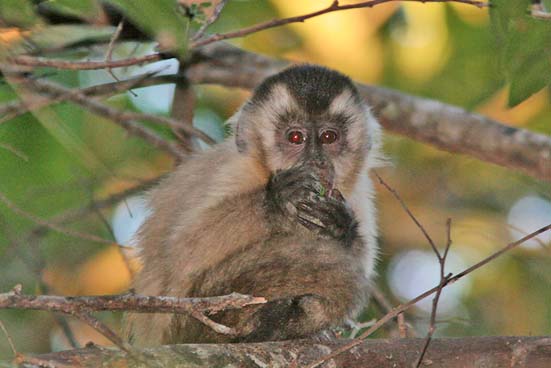 |
The most common monkey we encountered was Brown Capuchin Cebus apella (left). They are diurnal and arboreal, and were very bold at some sites. In the Pantanal, a troop used a overlook tower as their night roost, and were reluctant to move as we climbed down the ladder at dusk. There are lodges in which the windows must be locked, because capuchins have learned to 'break in' through half-opened windows. We also saw them in the Atlantic forests. |
A specialty of the riverine forests in the Pantanal was Black-tailed (Pantanal) Marmoset Mico melanura. Most believe that the population here will be split into a separate species once a full analysis has been undertaken. They are arboreal and have long, non-prehensile tails. Our closest encounter was during a walk along the woods edging the Rio Claro in the northern Pantanal (right). Primates heard but not seen this trip were Black Howler Aluatta caraya (Pantanal) and Dusky Titi Monkey Callicebus moloch (Itatiaia NP). |
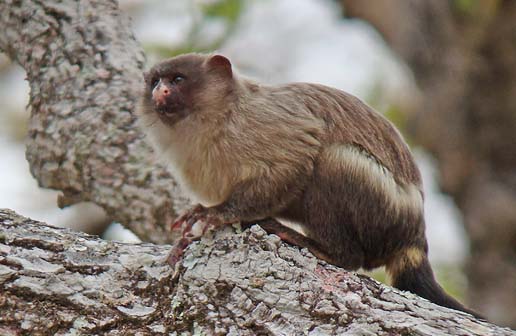 |
page created 4 Sep 2010
|
© Don Roberson 2010 |
